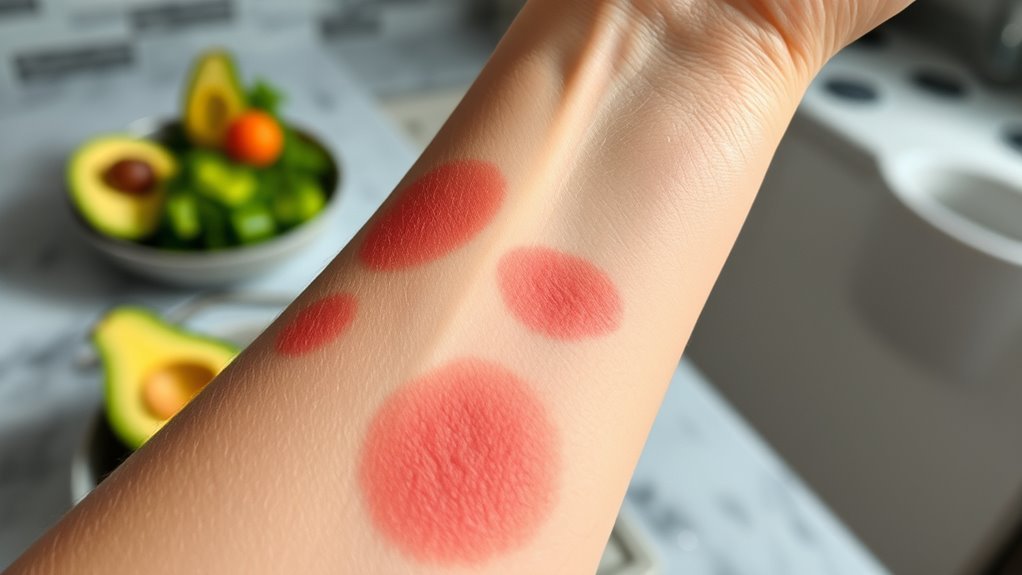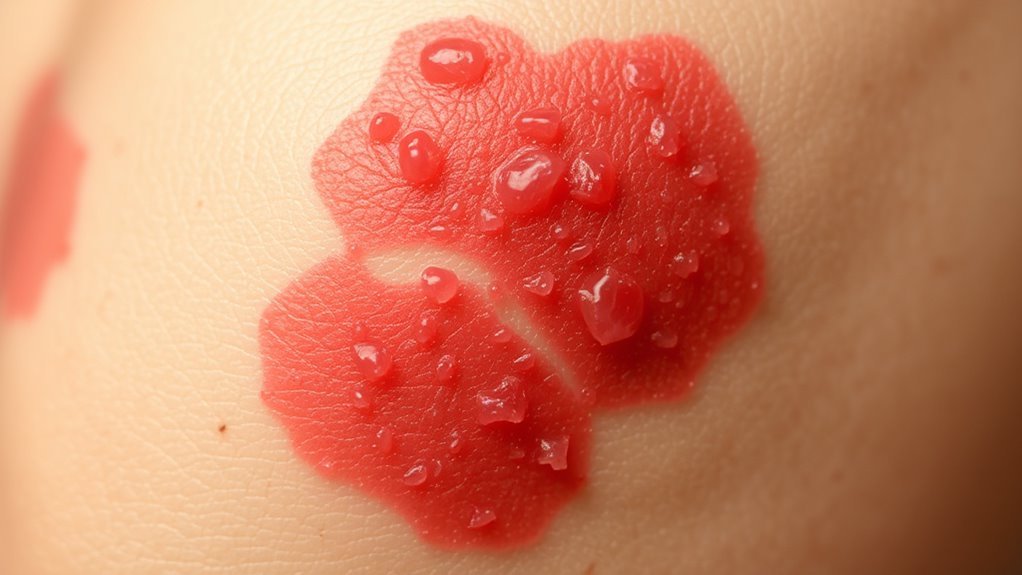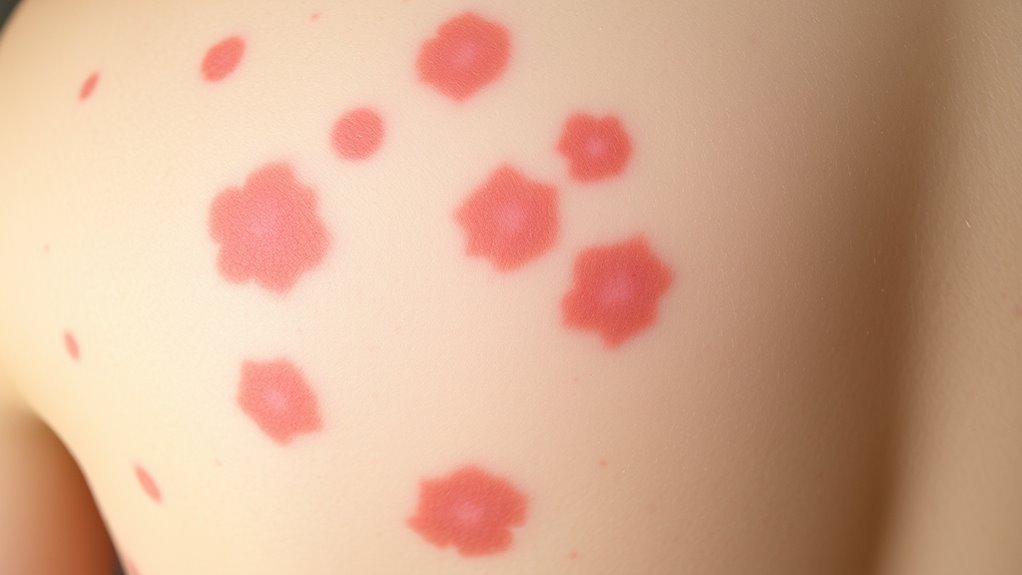Keto rash isn’t considered dangerous for most people. It’s a common response during your body’s adjustment to ketosis, presenting as red, itchy patches on the skin. While uncomfortable, it usually resolves with proper skincare and dietary adjustments. However, if the rash persists or worsens, it might indicate an allergy or other issues that need attention. Staying informed about your body’s reactions is key to a successful keto experience, and there’s more you can explore about management and prevention.
Understanding Keto Rash: What Is It?

When you commence on a ketogenic diet, you might notice an unusual skin condition known as keto rash. This rash typically appears as red, itchy patches on the skin, often located in areas where friction occurs, such as the armpits or groin. While the exact cause of keto rash isn’t fully understood, it’s believed to be related to the body’s adjustment to fat metabolism and changes in skin health due to lower carbohydrate intake. Some studies suggest that it may result from an increase in ketones or an inflammatory response. Although not dangerous, it’s important to monitor your skin condition. Staying hydrated and maintaining proper skin care can help alleviate symptoms as your body adapts to the keto diet.
Symptoms of Keto Rash: How to Identify It

Although keto rash is generally not harmful, recognizing its symptoms is essential for effective management. You may notice specific skin symptoms that can help identify this condition. Common indicators include:
| Symptom | Description | Severity Level |
|---|---|---|
| Red, itchy patches | Appears on the torso or limbs | Mild to Moderate |
| Blisters | Fluid-filled spots on the skin | Moderate |
| Scaling | Dry, flaky skin around affected areas | Mild |
If you experience these symptoms while following a ketogenic diet, it’s essential to monitor your condition. While keto rash can be uncomfortable, understanding these skin symptoms helps you address them effectively and regain your skin’s health, allowing you to enjoy your keto journey freely.
Causes of Keto Rash: Why Does It Occur?

Keto rash often arises from significant metabolic changes your body experiences when shifting to a ketogenic diet. Certain dietary triggers, such as specific fats or proteins, can exacerbate this skin condition. Understanding these causes can help you manage or prevent the rash more effectively.
Metabolic Changes Explained
As you shift into a ketogenic diet, your body undergoes significant metabolic changes that can sometimes lead to unexpected side effects, including keto rash. This condition often arises during the process of metabolic adaptation, as your body evolves from burning carbohydrates to utilizing fats for energy. In nutritional ketosis, your liver produces ketones, which serve as an alternative fuel source. However, this alteration can stress your body, triggering inflammatory responses in some individuals, particularly if there are underlying sensitivities or a rapid change in fat metabolism. While keto rash isn’t dangerous for most, it’s essential to understand that these metabolic changes can affect your skin’s health, prompting you to monitor your body’s reactions closely as you embrace this dietary freedom.
Dietary Triggers Identified
When shifting to a ketogenic diet, certain dietary triggers can contribute to the development of keto rash. Common triggers include high levels of histamines in foods like aged cheeses and cured meats, which can lead to skin irritation. Additionally, nutritional imbalances, such as deficiencies in vitamins A, D, E, and K, may exacerbate skin issues. For some individuals, excessive consumption of certain fats, particularly from dairy, can provoke inflammatory responses. It’s essential to maintain a balanced intake of nutrients while following a keto diet to minimize these effects. Monitoring your body’s reactions to specific foods can help identify and eliminate these dietary triggers, ensuring a smoother change to this lifestyle without the discomfort of keto rash.
Is Keto Rash Dangerous? Evaluating Health Risks
How concerning is keto rash for those following this popular diet? While keto rash can be uncomfortable and unsightly, it’s generally not dangerous. This skin condition, often resulting from the body’s adjustment to ketosis, typically presents as a red, itchy rash. Most importantly, the health implications are usually minimal. Keto rash is not linked to serious underlying health issues. However, it’s essential to monitor your body’s response to the keto diet. If the rash persists or worsens, it may indicate an allergic reaction or other skin condition, warranting further evaluation. Staying informed about your body’s signals can empower your dietary choices and guarantee your keto journey remains a positive experience.
Treatment Options for Keto Rash: What You Can Do
If you’re experiencing keto rash, making dietary adjustments and incorporating skin care remedies can help alleviate symptoms. Consider moderating your fat intake or increasing your carbohydrate consumption slightly to see if it improves your condition. Additionally, using gentle, hydrating skin care products may provide relief and support your skin’s recovery.
Dietary Adjustments
Although keto rash can be an uncomfortable side effect of a ketogenic diet, making specific dietary adjustments can help alleviate its symptoms. Start by ensuring nutritional balance in your meals; include a variety of healthy fats, proteins, and low-carb vegetables. This approach not only supports your body during ketosis but can also minimize inflammation. Additionally, consider meal timing; eating smaller, more frequent meals may help regulate your body’s response to ketosis and reduce the likelihood of rash development. Staying well-hydrated is essential as well, as dehydration can exacerbate skin issues. By making these adjustments, you can maintain your commitment to a ketogenic lifestyle while addressing the concerns of keto rash effectively.
Skin Care Remedies
Managing keto rash involves not only dietary adjustments but also effective skin care remedies. Incorporating a few simple practices into your skincare routines can help alleviate discomfort and promote healing. Here are some natural remedies you might find beneficial:
| Remedy | Description | Application |
|---|---|---|
| Aloe Vera | Soothes irritated skin | Apply gel directly on rash |
| Coconut Oil | Moisturizes and reduces dryness | Massage onto affected areas |
| Oatmeal Baths | Relieves itching and inflammation | Soak in colloidal oatmeal |
| Witch Hazel | Acts as an astringent | Dab on with a cotton ball |
Preventing Keto Rash: Tips for a Safer Keto Journey
As you commence on your ketogenic journey, understanding how to prevent keto rash can be essential to your overall success and comfort. Prioritizing skin health while on the keto diet not only enhances your experience but also minimizes potential discomfort. Here are some tips to help you along the way:
- Stay hydrated: Drink plenty of water to keep your skin moisturized.
- Monitor your carb intake: Gradually reduce carbs to reduce the likelihood of rash.
- Use gentle skincare: Opt for non-irritating products that support skin health.
- Incorporate healthy fats: Consuming adequate healthy fats can help improve skin condition.
Frequently Asked Questions
Can Keto Rash Occur Without Following a Strict Ketogenic Diet?
Did you know that around 20% of people on a ketogenic diet experience keto rash? Curiously, this skin condition can occur even without strictly following a keto diet. Factors like diet variations or sudden changes in food intake can act as keto rash triggers. If you’re experimenting with low-carb diets or intermittent fasting, it’s essential to be aware of these potential skin reactions, as they might pop up unexpectedly.
Is Keto Rash More Common in Certain Skin Types?
Keto rash can indeed be influenced by skin type prevalence and individual rash susceptibility. If you have sensitive or reactive skin, you’re more likely to experience this rash compared to those with resilient skin types. Factors like genetics and environmental conditions can also play a role in how your skin responds to dietary changes. It’s crucial to monitor your skin’s reaction if you’re adopting a ketogenic lifestyle, regardless of your skin type.
How Long Does Keto Rash Typically Last?
Keto rash duration can vary, but it typically lasts from a few days to several weeks. You’ll often notice symptoms like red, itchy patches appearing as your body adapts to a ketogenic diet. The symptoms timeline may differ based on individual factors, such as skin type and overall health. Most people find that the rash subsides as their body adjusts, but staying hydrated and maintaining proper skincare can help alleviate discomfort during this period.
Can Medications Trigger or Worsen Keto Rash Symptoms?
You might not realize it, but certain medications can indeed trigger or worsen skin reactions associated with keto rash. Some people find that medication effects can amplify their symptoms, leading to more discomfort. It’s essential to monitor how your skin reacts after starting any new treatment. Always consult your healthcare provider if you suspect a link, as they can help determine if your medications are contributing to your keto rash and suggest alternatives.
Are There Any Long-Term Effects of Having Keto Rash?
While keto rash typically resolves over time, it can lead to long-term impacts on your skin sensitivity. If you experience persistent rashes, it’s essential to monitor your skin’s response to dietary changes. Some individuals may find their skin becomes more reactive to irritants or allergens post-rash. Maintaining a balanced diet and addressing any triggers can help minimize these long-term effects. Always consult a healthcare professional for personalized advice regarding your skin health.


